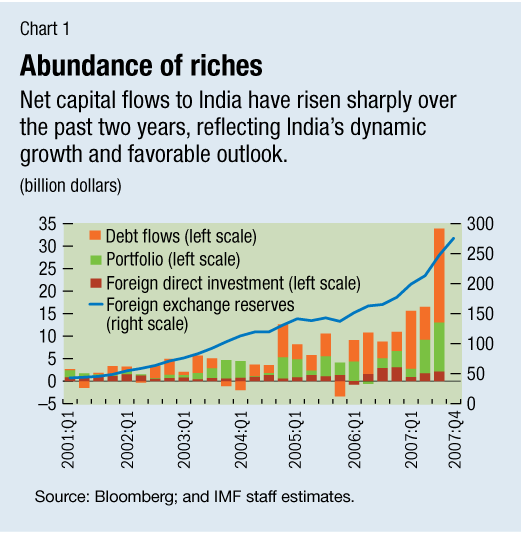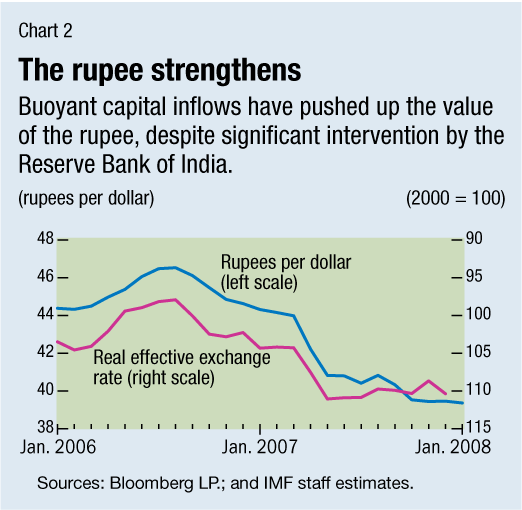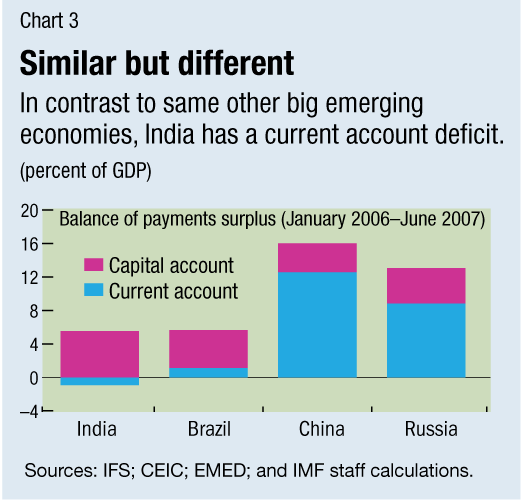
Typical street scene in Santa Ana, El Salvador. (Photo: iStock)
IMF Survey: India's Record-High Capital Inflows Pose Policy Challenge
February 4, 2008
- India's recent stellar economic performance attracting large capital inflows
- Although a boon, inflows also complicate monetary, exchange rate policies
- To sustain growth, India needs to tackle fiscal issues and implement structural reforms
Over the past five years, average growth of 8¾ percent has made India one of the world's fastest-growing economies.

Weaver near Madras, India: country's recent economic performance has been nothing short of stellar, IMF report says (photo: Dibyangshu Sarkar/AFP)
IMF annual economic health check
The rapid growth has brought significant dividends to the population at large: the poverty rate fell from 36 percent in 1994 to less than 28 percent in 2005, inflation has remained contained, and the current account deficit is moderate. This performance pays tribute to India's sound macroeconomic policies and past structural reforms.
The outlook is equally positive. Rising incomes should support consumption growth, and robust business confidence, high capacity utilization, and buoyant corporate profits will bolster investment.
On the external front, a weakening of India's key trading partners is likely to slow merchandise export growth in the near term. However, India's service exports (IT and business process outsourcing) could benefit from increased demand as industrial economies look to cut costs. Over the next few years, growth is likely to moderate toward its potential rate of 8 percent, buttressed by favorable demographics and robust productivity gains.
Surging capital inflows
India's favorable environment has attracted the attention of foreign investors. Capital inflows have surged over the past two years (see Chart 1). In 2005, net capital inflows amounted to $25 billion. By 2007 (January-September), they had more than doubled, to $66 billion.

Lending to Indian corporates has been the biggest contributor, although portfolio investment has also risen rapidly. Foreign capital has been attracted by India's productivity-driven growth boom, its increasing financial integration with the global economy, and higher interest rates than abroad. Inflows are projected to remain significant, reflecting India's continued strength at a time when the world economy is weakening.
India's policy conundrum
Although capital inflows are supplying much-needed financing to Indian corporates and banks, they are also making monetary and exchange rate policy more challenging. Capital inflows caused the rupee to appreciate by 7 percent in real effective terms last year (see Chart 2). This has raised concerns about India's competitiveness, particularly in the labor-intensive textile, garment, and leather industries.

Capital inflows have also increased the money supply, which then raises inflationary pressure. In short, India is facing the policy challenges of the "impossible trinity": when there is free movement of capital, it is impossible to both target the exchange rate and maintain an independent monetary policy.
Responding to the challenge
The Reserve Bank of India (RBI) has responded to this policy challenge in a flexible manner. It allowed exchange rate flexibility to absorb pressures from capital inflows, as noted above, although it has also intervened heavily in the foreign exchange market: last year, reserves rose by nearly $100 billion, to about $275 billion.
The RBI has also actively withdrawn liquidity from the system. And monetary policy has been tightened, with the result that India has maintained a wide interest rate margin with the rest of the world (though this may, in turn, be encouraging more capital inflows). Finally, the RBI is gradually liberalizing capital outflows in line with India's medium-term objective of capital account liberalization.
Some restrictions on capital inflows have recently been introduced, primarily on corporate borrowing. International experience suggests that these restrictions are unlikely to have much impact on capital inflows because investors and borrowers find ways to evade them. But, to the extent that they do bite, they raise concerns about the potential impact on financing for infrastructure projects, which tend to require the longer-term financing that may be more readily available from foreign lenders.
Shared experiences
Despite such restrictions, India's vibrant outlook and sizable capital demands mean that capital inflows are likely to remain large. This would be consistent with the experience in other Asian countries around growth take-offs. Since restrictions on capital inflows are not likely to be effective, allowing greater exchange rate flexibility and improving liquidity management may be a better way to deal with continued capital inflows.
India's experience is not entirely unique. Brazil, Russia, and China have also experienced significant balance of payments surpluses recently. Unlike India, however, these countries have all maintained current account surpluses (see Chart 3). What is interesting is that despite the differences in their exchange rate regimes, all four countries have intervened heavily in the foreign exchange market. But they have differed in the extent to which the excess of foreign exchange inflows has been sterilized.

To safeguard its inflation target, Brazil has fully sterilized its intervention in the foreign exchange market. Both China and India have undertaken partial sterilization, and Russia has broadly limited its sterilization to oil-related inflows. As a result of these varied policy responses, the four countries' currencies appreciated to varying degrees in real effective terms between December 2006 and June 2007: 4 percent in China, 8 percent in India, 13 percent in Russia, and 17 percent in Brazil.
Not just a monetary policy challenge
Financial globalization has placed a greater premium on broadening and deepening India's financial and capital markets. This would help channel capital inflows to their most productive use, accommodate higher exchange rate volatility, and support financial stability. In this regard, the corporate bond market could play a more important role as an alternative source of funds, while better-developed onshore derivatives markets would enable corporations to better manage the risks associated with India's financial integration.
On the fiscal front, further consolidation remains important to sustain growth and manage financial globalization. Despite India's impressive revenue performance, fiscal consolidation has stalled and public debt remains high, squeezing the fiscal space needed for public investment in physical and social infrastructure. Both expenditure and revenue measures are needed, including rationalizing subsidies, cutting tax exemptions, enhancing tax administration, and broadening the tax base. A tighter fiscal stance could also limit the inflationary impact of capital inflows.
Structural reforms are long overdue and remain critical for shoring up India's competitiveness in the face of appreciation pressures. These reforms include investment to help close India's major infrastructure gaps, improving education to meet rising shortages of skilled labor, and making labor markets more flexible. Moving the economy forward in this direction will help India prolong its "dream run" of rapid growth and macroeconomic stability for many years to come.


